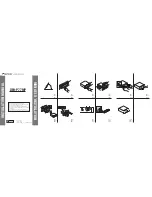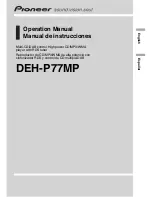
37
9. RA-4/4A Protect Circuit Troubleshooting
Chapter 9 - RA-4/4A Protect Circuit Troubleshooting
Overview
The protect circuits in the RA-4 chassis contain several additional sections of monitoring than the RA-3. The
high voltage and horizontal deflection circuits are separate, so monitoring deflection loss is necessary. Several
more low voltage lines are also monitored. The self-diagnostics feature will assist in isolating a particular circuit,
but not all of the monitored lines are sensed by this feature. Below is an example of the diagnostics page which
is entered by pressing “DISPLAY”, “5”, “VOL –”, and “POWER”.
Self Check
2:
+B OCP
00
3:
+B OVP
00
4:
V Stop
00
5:
AKB
00
6:
H Stop
00
7.
HV
00
8:
Audio
00
101:
WDT
00
The numbers on the left indicate how many times the timer LED flashed, which designates the probable cause of
the shutdown. The flashes on the LED will occur at one second intervals, followed by a three second separation
period and repeat again. The numbers at the extreme right indicate how many times the problem occurred up to
99 events. You can see why this is beneficial for intermittent troubleshooting. It is always a good idea to clear the
events before exiting and that can be done by pressing “8” “enter” on the remote. This is not the same as
pressing these buttons in the service mode. It will only clear the events and not reset customer defaults. Beware
that the service manual instructs you to enter the service mode to clear these and that is a mistake. You can do
it right from this screen. Let us briefly cover each one.
+B OCP:
Excessive current on the 135V line. This is usually caused by flyback problems or secondary loads on
the line. The circuit could also be tripping for no reason. This is why you should always monitor AC current while
the unit is shutting down. It will help you to know if you are really dealing with an over-current condition and you
can then be more cautious in troubleshooting.
+B OVP
: The 135V line has exceeded 139 volts. Go back to the Chapter 8 on troubleshooting regulator problems.
V Stop:
The vertical deflection circuit has stopped operating. This indication can also occur if the high voltage
circuit fails since it provides the +15 and -15 volt supply rail to the vertical output. Loads on the I
2
C data and clock
bus can also be the source of this problem.
AKB:
One or more CRT cathodes are unable to generate sufficient current to return a good feedback pulse. The
AKB detect circuit may also have failed. It is common to see multiple events in this diagnostic feature along with
registered HV failures. See the special section in Chapter 27 on AKB at the end of this manual.
H Stop:
Horizontal deflection has failed. Since the unit has a separate high voltage circuit, the set will shut down
to protect the CRTs. This will be covered in Chapter 10,
which deals with the deflection circuits.
HV:
High voltage has risen to unacceptable levels or excessive current is being drawn in the flyback transformer.
















































